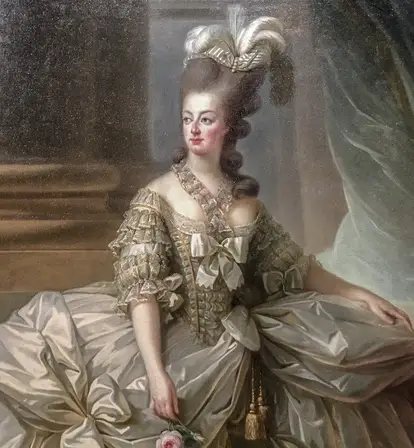She likely never said "Let them eat cake," but Marie Antoinette's extravagant spending plunged France into economic turmoil and led to her public execution in 1793.
Queen Marie Antoinette was the last queen of France before the French Revolution took down the monarchy.
Detestably nicknamed “Madame Déficit” by the public and her enemies at court, Marie Antoinette’s lavish lifestyle symbolized the unchecked extravagance of the French elite and led to her gruesome beheading.
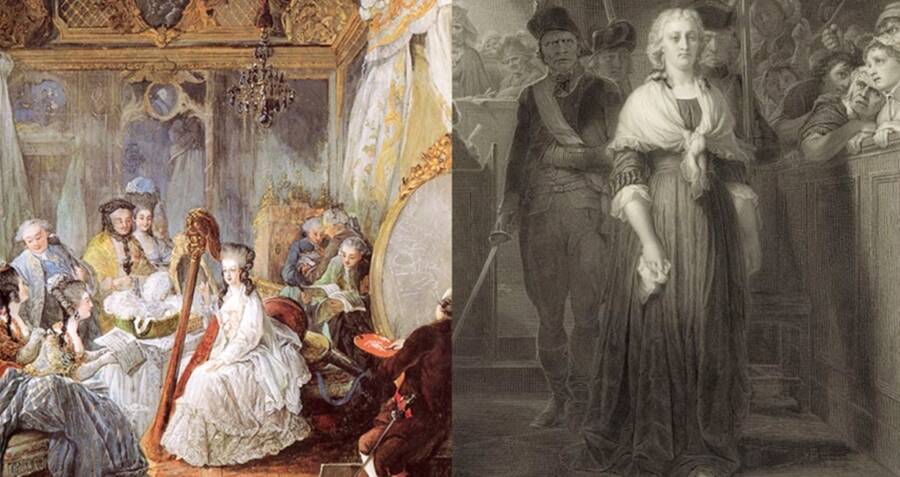
Wikimedia CommonsLeft: Marie Antoinette during one of her salons; right: Marie Antoinette facing the French tribunal.
But was Marie Antoinette really the frivolous queen that the revolutionaries painted her as? Or was she just an easy scapegoat as France languished in economic turmoil?
Who Was Marie Antoinette?
Although she lived and died as the most notorious queen in French history, Marie Antoinette — born Maria Antonia Josefa Johanna — was an Austrian-Hapsburg, the longtime rivals of the French Bourbons.
Like many royal marriages of the time, Marie Antoinette’s betrothal to future king Louis-Auguste was a match made for political gain. The marriage was the handiwork of her mother, the formidable Austrian Empress Maria Theresa.

Wikimedia CommonsBefore she married the heir to the French throne, Marie Antoinette was an Austrian princess. Circa 1767-68.
Maria Theresa forged the alliance to soothe the longstanding animosity between France and Austria, mostly as a means to subvert the growing power of Prussia and Great Britain, and viewed her daughter’s marriage to the French heir as the perfect solution.
Antonia’s mother ruled over all of her 16 children as she did her empire — with an iron fist. The empress was particularly harsh and verbally abusive toward the carefree Antonia, even after she assumed the throne.
“Your beauty… frankly is not very great. Nor your talents nor your brilliance,” Maria Theresa wrote her daughter after she became the queen of France. “You know perfectly well that you have neither.”
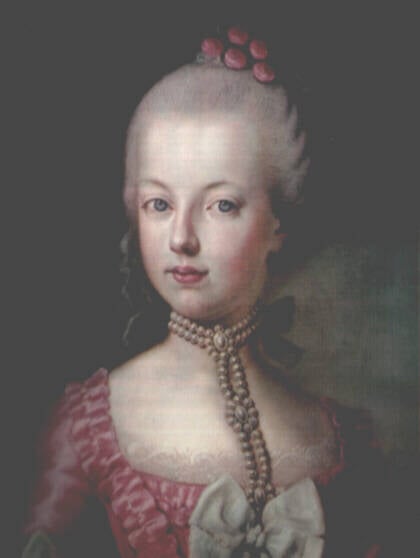
Wikimedia CommonsAfter she married Louis-Auguste at age 14, Marie Antoinette became the Dauphine of France. In this portrait by Austrian painter Joseph Kreutzinger, she is 16 years old.
Nevertheless, Maria Antonia married Louis-Auguste on May 16, 1770, at the age of 14. They married at the decadent Versailles palace, and she adopted the French styling of her name, Marie Antoinette.
Four years later, her 19-year-old husband King Louis XVI became King of France and she, only 18, became queen.
Despite the friendship they eventually forged, their marriage got off to a rocky start after news spread that their wedding night had been a disaster. It would reportedly take seven years before husband and wife would finally consummate their marriage.
The king suffered from phimosis, in which tight foreskin can cause painful erections. Unable to become physical with her husband, the young Marie Antoinette turned her gaze to parties, games, and — according to palace rumors — other men.
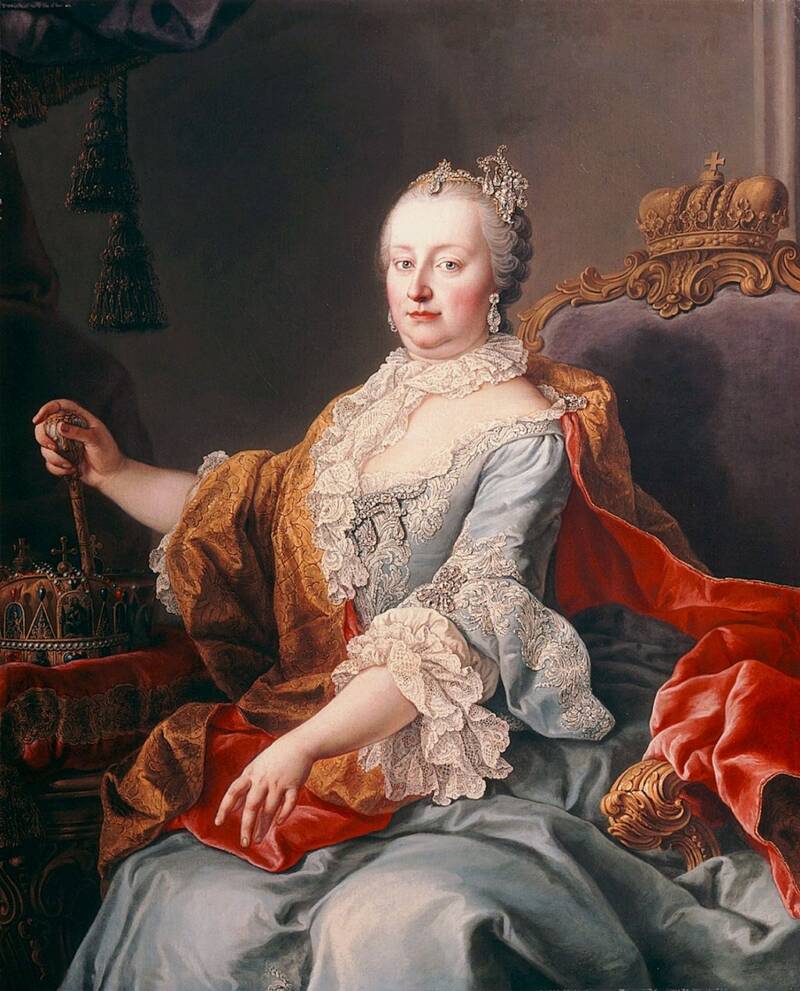
Wikimedia CommonsAustrian Empress Maria Theresa, Maria Antoinette’s mother, was known by her political opponents as a fierce ruler.
The dire situation in the royal bedroom was not just a domestic matter; for Maria Theresa, it could have cost her family politically.
At the behest of their mother, Antoinette’s brother, Holy Roman Emperor Joseph II, paid his younger sister and the king a visit in hopes of rectifying their sexual relationship. He traveled under the false name of the Count of Falkenstein in order to avoid stuffy royal protocols that would hamper his mobility.
Before departing for Austria, Joseph II gave the couple some much-needed advice: Marie Antoinette needed to be more affectionate with her husband, and Louis XVI should undergo a simple surgery to fix things in the bedroom.
The Austrian emperor’s words of wisdom seemed to have done the trick: A year later, Marie Antoinette had her first child, a little princess named Marie-Thérèse Charlotte. The queen would ultimately have four children, only one of whom survived into adulthood.
France’s Teen Queen

Wikimedia CommonsQuenn Marie Antoinette was reviled for her extravagant lifestyle during the French recession.
Still, Queen Marie Antoinette and King Louis XVI were more like friends than a married couple. The queen spent more time with her close circle of confidants than with her husband.
That’s at least partly because they were polar opposites. While Marie Antoinette was spirited and lighthearted, the king was much more serious and restrained.
She reveled in the social spotlight, putting on lavish balls that went until dawn and gambling away the monarchy’s money. Meanwhile, Louis was gifted in the sciences and languages, and preferred to read quietly and tinker with locks.
“My tastes are not the same as the King’s, who is only interested in hunting and his metal-working,” the queen wrote to a friend in April 1775. She also told her trusted adviser, Austrian ambassador Comte Florimond de Mercy-Argenteau, that she was perpetually “terrified of being bored.”
Queen Marie Antoinette had extravagant taste, and while the coffers of the French kingdom dwindled and the cost of bread skyrocketed, that did not stop Marie Antoinette from spending — and spending lavishly.
She spent a fortune on decadent clothes, shoes, wigs, and jewelry — mostly diamonds and pearls — just for the fun of it.

Wikimedia CommonsKing Louis XVI had a serious and timid temperament, the polar opposite of Marie Antoinette.
Once she sported a towering bouffant dubbed the “inoculation pouf,” named after the pricey hairpiece depicting a club hitting a snake in an olive tree. The piece celebrated her success in persuading her husband to be vaccinated against smallpox.
She also spent exorbitant amounts of money on real estate. Most notably, she completely redecorated the Petit Trianon, a “modest” three-story neoclassical château on the grounds of Versailles that had been commissioned by her husband’s grandfather. Antoinette transformed the home’s modest interiors and imbued them with her signature zeal for color and frivolity.
There were also several renovations done to her private chambers at the Versailles Palace, which she decorated exquisitely and expanded from its original size to include the rooms on the floor above. There was also a miniature summer apartment built upon her request containing a bedchamber, library, and bathroom. The rooms were decked out in floral pastels and minted in gold, marble, and bronze details.
Marie Antoinette, coming from the much more relaxed customs of the Austrian royals, also rebelled against the confines of traditional royal etiquette she was obligated to perform, including a waking-up ceremony, entertaining royal audiences, hosting public meals, and other rigid customs.
“I put on my rouge and wash my hands in front of the whole world,” she complained, speaking of a daily ritual where dozens of courtiers hover around her as she dresses.
But underneath her outrageous behavior was also a tender young heart. She was described as a compassionate individual by those close to her. She once tended to a peasant gored by a stag and adopted several children.
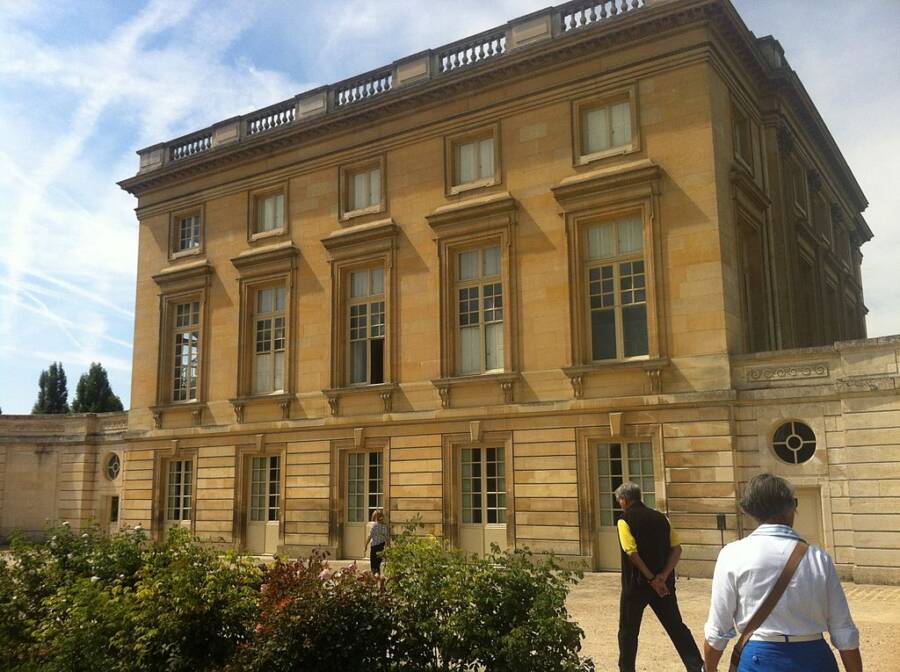
The queen spent a fortune of France’s money to construct the Petite Trianon, her getaway compound.
“She was so happy at doing good and hated to miss any opportunity of doing so,” wrote Madame Campan, Marie Antoinette’s First Lady of the Bedchamber.
But her shamelessness outshone her tenderness, and became well-known to palace insiders and the public, much to the chagrin of her steely mother. After hearing of her daughter’s insolence, the Austrian empress warned her to fix her ways.
“You lead a dissipated life,” Maria Theresa wrote to the French queen in 1775. “I hope I shall not live to see the disaster that is likely to ensue.”
Her mother’s words would prove to be an early premonition of her unruly daughter’s fate.
A Queen Turned Public Enemy Number One

Wikimedia CommonsQueen Marie Antoinette’s popularity plummeted as the public learned about her excesses.
Before King Louis XVI took the throne, France was already spiraling into an economic recession. Although Queen Marie Antoinette’s extravagant spending was certainly not the sole cause of France’s downfall, it didn’t help the economy — or her public perception.
Her growing unpopularity was exacerbated by her political incompetence. Under the influence of her controlling mother and brother, Marie Antoinette committed one political faux pas after another, pushing for Austrian interests in court. Her French subjects who were already wary of the foreigner queen from Austria, with which France shared a hostile history, and now they had all the more reason to suspect her of disloyalty.
One of the most audacious dissidents against Queen Marie Antoinette in court was Marie Adélaïde, the aunt of Louis XVI, who had a habit of referring to the queen as “The Austrian Woman.” The king’s aunt, whom he trusted as a political adviser earlier in his reign, would often hold private salons inviting members of the Anti-Austria Party where satirical poems about Marie Antoinette were read aloud.
But the queen had her own tight-knit posse with whom she mostly secluded herself. Among them, her ladies-in-waiting Princess de Lamballe and the Duchess de Polignac, and her rumored lover, Swedish Count Axel von Fersen.
Marie Antoinette, exhausted by her boring royal duties and the animosity she faced at court, preferred to hide away with them at her Petit Trianon compound.
This closed clique was another faux pas by the French queen, as the act inevitably alienated and offended other important officials from the French court, costing her supporters within the palace walls.
Marie Antoinette’s unabashed decadence, her disregard for royal protocol, and her obvious intent in upholding the last gusts of the monarchy in the wake of growing resistance from its people made her an easy target for revolutionaries. Here was the foreign queen basking in opulent delights while the rest of France was starving, a narrative that would underly most of the slander against Marie Antoinette.
Did Marie Antoinette Really Say “Let Them Eat Cake?”
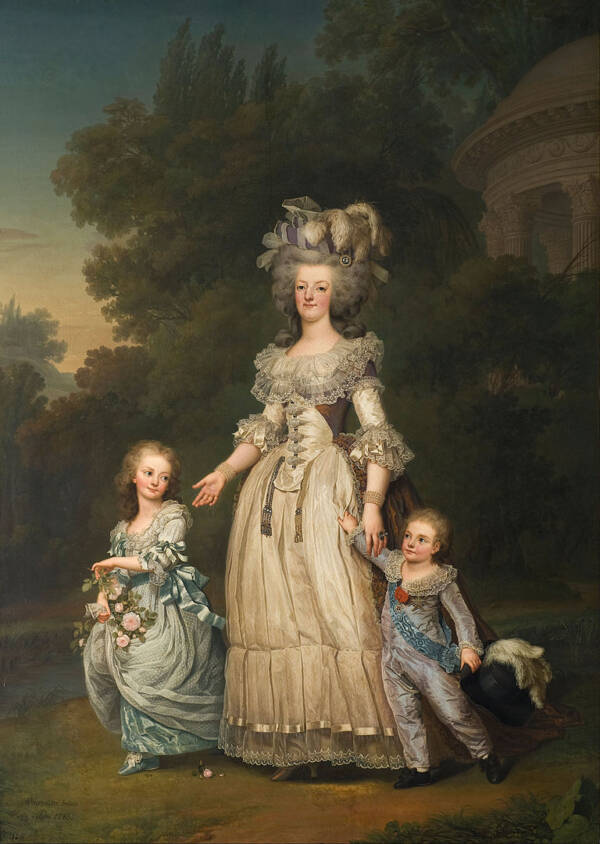
Wikimedia Commons.Marie Antoinette with two of her children. Only one out her four kids survived to adulthood.
Marie Antoinette’s out-of-control spending earned her the name “Madame Déficit.” Revolutionaries even made pornographic caricatures of the trysts rumored to take place in her apartments at Versailles.
One anonymous pamphlet from circa 1783 alleged that “debauchery and agitation of passions were observed in Marie Antoinette’s life… Men, women, everything was as she liked. She was satisfied with everything. Marie Antoinette also was unfaithful to Louis XVI and fooled him too.”
Historians argue that the compounded misogynistic slander that painted the queen as an adulterer also had to do with the fact that King Louis XVI had never taken a mistress, a peculiar practice at the time for a royal. They believe that any animosity that would have been directed at a king’s mistress was now transferred squarely to the queen. Plus, given her penchant for frivolity, she was easy to paint as corrupt.
Somehow, all the ill rumors spoken of Queen Marie Antoinette eventually led to one of the most famous misquotes in history. After she was informed that the French public were too poor to buy bread, the infamously superficial royal was said to have uttered the mocking words, “Let them eat cake.”
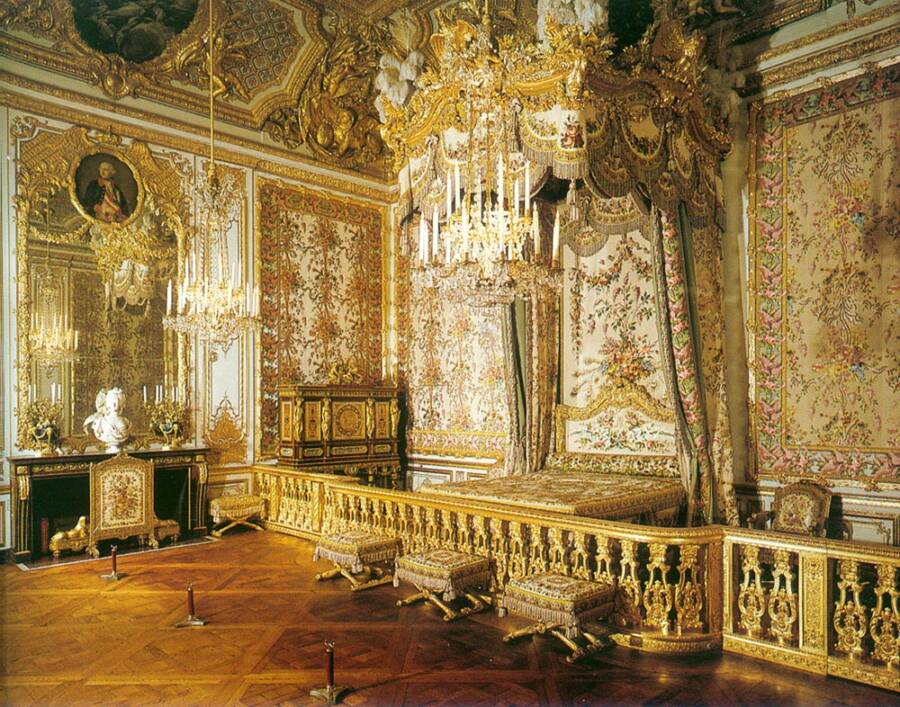
Wikimedia CommonsMarie Antoinette’s extravagantly decorated private chambers at Versailles.
But those words, which in French were “Qu’ils mangent de la brioche,” meaning “Let them eat brioche (sweet bread),” probably never left the queen’s lips.
There are many theories as to the origins behind the horrendous attribution. According to historian Antonia Fraser’s biography of the young queen, Marie Antoinette: The Journey, the quote was more likely to have been uttered by Spanish Princess Marie Thérèse, who married into the French monarchy long before Marie Antoinette’s arrival.
Another possible origin is a 16th-century German folktale in which a noblewoman wondered why the poor didn’t just eat “krosem,” a kind of sweet bread. Centuries later, when Marie Antoinette was just nine years old and still living in Austria, French philosopher Jean-Jacques Rousseau wrote the phrase “Qu’ils mangent de la brioche” in his own autobiography, attributing it to a “great princess.”
Many hypothesize that the mocking words were then fictitiously attributed to Marie Antoinette to possibly fuel the revolution against the French monarchy. No matter how it’s sliced, one thing is clear: there is no written or oral evidence that anyone actually witnessed the queen uttering those words.
In fact, Marie Antoinette’s true sentiments might have been just the opposite. In a letter to her mother around the time of France’s bread shortage, she wrote, “It is quite certain that in seeing the people who treat us so well despite their own misfortune, we are more obliged than ever to work hard for their happiness.”
The French Revolution Arrives
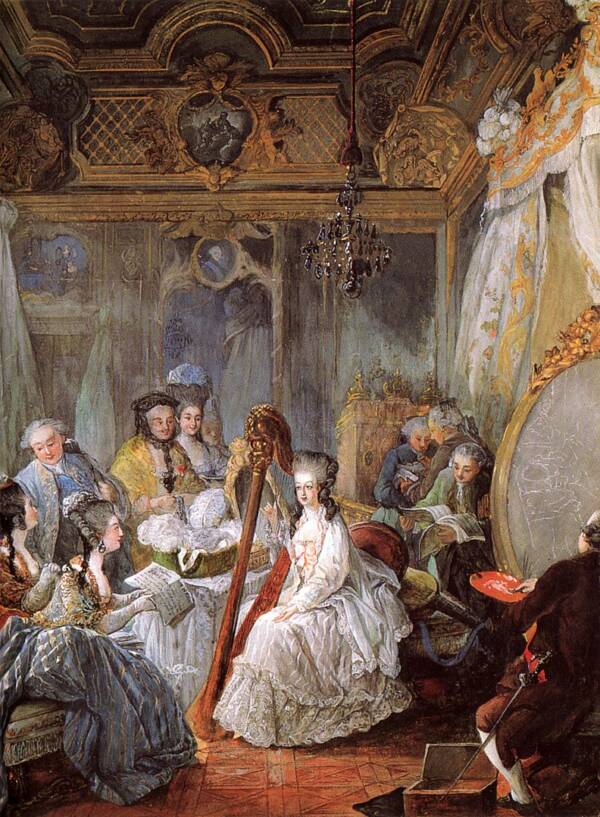
Wikimedia CommonsMarie Antoinette preferred to seclude herself with a close group of confidants, angering the rest of the court. She reportedly a very good harpist.
By 1786, Marie Antoinette’s popularity with the French public had suffered immensely. Libelous caricatures and gossip about the her hedonistic behavior and trysts with palace guests — virtually none of which have been confirmed by the actual historical record — continued to rage on, pushed by anti-monarchists.
There was a great scandal involving the swindling of an extravagant necklace made of 650 diamonds worth $4.7 million today which had unfortunately been pinned on the queen — known as the “diamond necklace affair” — which made matters even worse.
But perhaps most damaging were rumors that her children were illegitimate. Many believed that at least two of the royal heirs were in fact the result of her amorous affair with the Swedish Count Fersen, who often lingered by Marie Antoinette’s side. While it’s impossible to establish the true paternity of her children, we do know that Marie Antoinette exchanged intimate letters with the count.
“I love you and will love you madly all my life,” Count Fersen wrote to Marie Antoinette in one of their many letters. She, in turn, wrote back that he was “the most loved and loving of men” and unabashedly told him that “my heart is all yours.” Their apparent love for one another would prove significant to Marie Antoinette’s failed escape after the monarchy’s fall.
Growing public discontent due to severe food shortages and an increasingly depleted French treasury (fueled by years of war and France’s support for the American Revolution) turned into a demand for the absolution of the French monarchy.
On July 14, 1789, some 900 Parisian workers and peasants took matters into their own hands. They stormed the gates of the Bastille prison to seize arms and ammunition. Against the behest of Marie Antoinette, King Louis XVI refused to send troops in order to quell the insurrection. Thus, the French Revolution began.
In October, another mob made up of thousands of Parisians — mostly women — walked 12 miles from Paris’s city hall to Versailles; they wanted to bring King Louis XVI and his wife to Paris so that they may be held accountable for the misery of the French people.
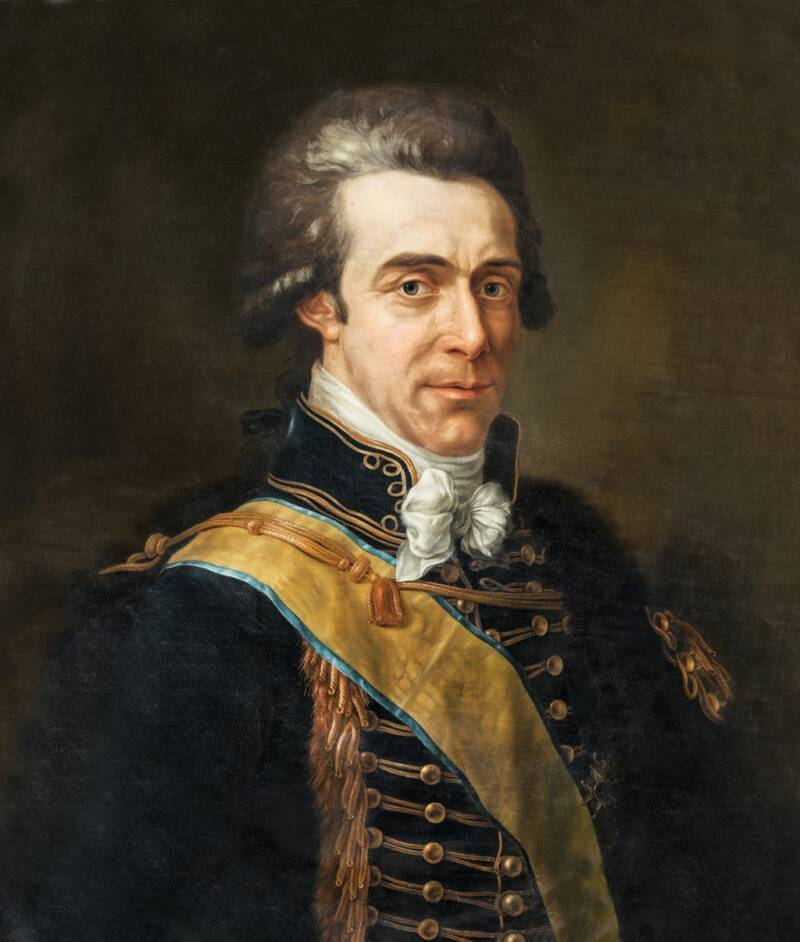
Wikimedia CommonsThe queen’s alleged lover, Count Axel Von Fersen, who was instrumental in the planning of the French royal’s escape from Versailles at the dawn of the French Revolution.
When the crowds arrived at Versailles, the mob had ballooned to 10,000 people. When someone cried out for the queen to show herself on the balcony, she did, bowing her head down so low toward the mob of angry Parisians that, for a moment, her grace under siege was welcomed with chants of “Long live the queen!”
But Marie Antoinette, having lived under the scrutiny of a critical public gaze for so long, knew that it wouldn’t last long.
“They are going to force us to go to Paris, the King and me, preceded by the heads of our bodyguards on pikes,” she said when she retreated back into the palace. Within hours, the protesters — indeed carrying pikes stuck with the heads of her guards — captured the royal family and moved them to the old Tuileries Palace in Paris.
The French royal family lived under surveillance at their new residence. But while King Louis XVI could hardly survive under watchful guard, given his indecisive and tender temperament, Marie Antoinette’s tenacity spurred her into action.
The End Of The French Monarchy And Marie Antoinette’s Life
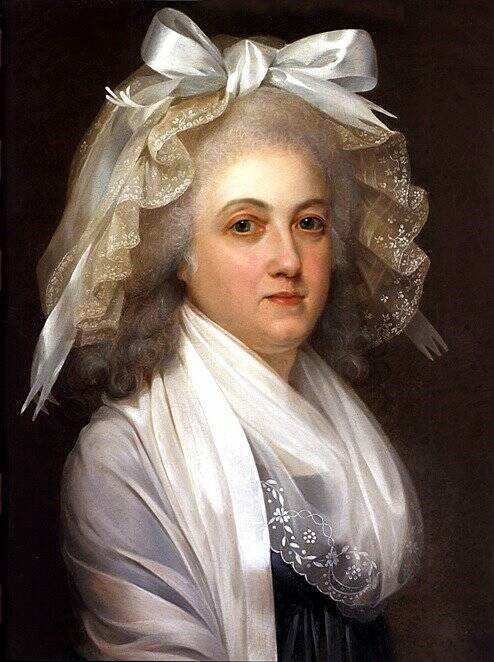
Wikimedia CommonsMarie Antoinette in the Temple Tower, circa 1792.
During their captivity at Tuileries, Marie Antoinette held council with the ministers and ambassadors, and through diplomatic dispatches urged other European sovereigns to invade France so that the insurgency of the French revolution may be kept at bay.
For her maturity as queen under duress, the Comte Honoré de Mirabeau, leader of the increasingly anti-monarchist National Assembly, allegedly remarked that she was “the only man at court.” In the weeks following the French Revolution, the National Assembly dissipated the rights of the clergy and monarch, and proclaimed the Rights of Man and a free press.
After all attempts by Marie Antoinette to put down the resistance failed, the royal family finally planned to escape from Paris. With the help of Marie Antoinette’s lover Count Fersen, the king and queen and their children boarded a coach to Montmédy, near the Austrian-controlled Netherlands.
But the coach was accosted on their way. Captured by National Guardsmen troops under the order of the National Assembly, the royals returned to Paris as captives once again.
In the years following their recapture, Louis XVI remained king so that the new constitution, which would allow shared equal powers between the king and the Legislative Assembly, would be legitimized.
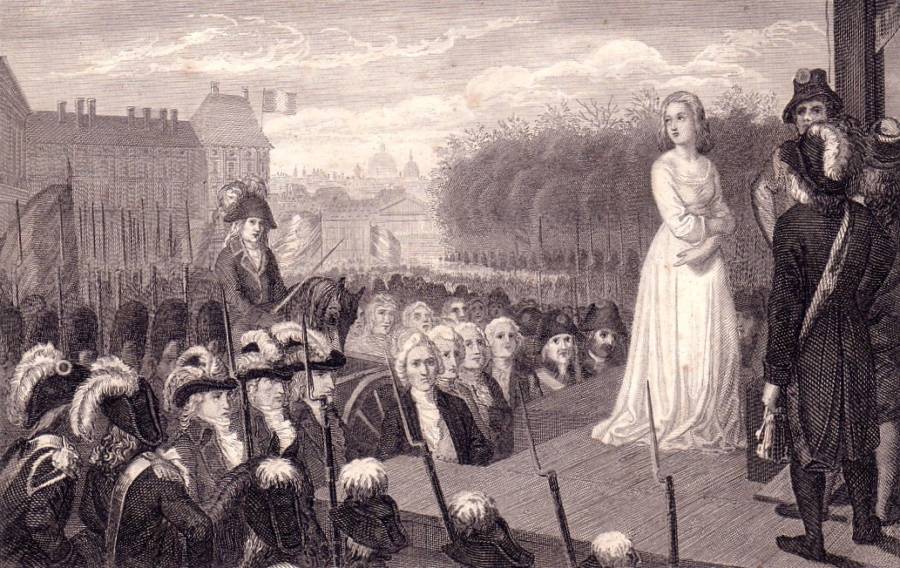
Wikimedia CommonsThe execution of Marie Antoinette.
Marie Antoinette, meanwhile, desperately continued to seek help where she could. She wrote to conservatives inside the Assembly for their support to uphold monarchy rule and corresponded with European dignitaries, arguing that the “monstrous” constitution was “a tissue of unworkable absurdities” and the Assembly was “a heap of blackguards, madmen, and beasts.”
The First French Republic was proclaimed on Sept. 22, 1792. In January, King Louis XVI was executed after being found guilty of high treason by a national tribune. With his death by the guillotine came the death of the French monarchy.
Marie Antoinette, who had been imprisoned in the Temple, was then moved to the Conciergerie shortly after the king’s execution. She received the same fate as her husband when she was executed — also by beheading — in October 1793.
In 1815, after the Bourbons regained power over France, her and her husband’s remains were transferred to the Basilica of Saint-Denis.
Marie Antoinette On The Big Screen
The life and trials of France’s young queen continue to fascinate academics and the public even 200 years after her death. Many have tried to capture Marie Antoinette’s tragic tale, both with the written word and on screen.
“She was decisive where he was indecisive… She was courageous when [the king] was vacillating,” biographer Antonia Fraser concluded in a PBS documentary.
In 2006 award-winning filmmaker Sofia Coppola wrote and directed the effervescent biographical film, Marie Antoinette, starring Kirsten Dunst in the titular role. The script was based on Fraser’s book, a decidedly sympathetic portrayal of the notorious queen.
Coppola was granted unprecedented access to Versailles Palace to shoot the film, which allowed the filmmaker to accurately capture the queen’s famed opulence. Even so, much like the queen’s reputation, the film received mixed reviews and opened to a clash of applause and a few boos during its premiere screening at the Cannes Film Festival.

Leigh JohnsonThe 2006 film Marie Antoinette opened to mixed reviews.
“History remembers the queen for her wastrel ways, indifference to human suffering (‘Let them eat cake’) and death by guillotine, but Ms. Coppola’s period film, which is playing in competition, conceives of her as something of a poor little rich girl, a kind of Paris Hilton of the House of Bourbon,” wrote the New York Times.
There is no denying that Marie Antoinette’s reign was marred by controversy, not undue to her own immature actions.
But though a critical examination of Marie Antoinette’s life is essential, it’s also worth noting some of the exaggerations bestowed upon her reputation by propagandists of the French Revolution.
Regardless, Marie Antoinette will forever remain one of the most infamous queens to have ever lived.
Now that you’ve learned about the incredible story of Marie Antoinette, read about Marie Laveau, New Orleans’ witchy Voodoo queen.
